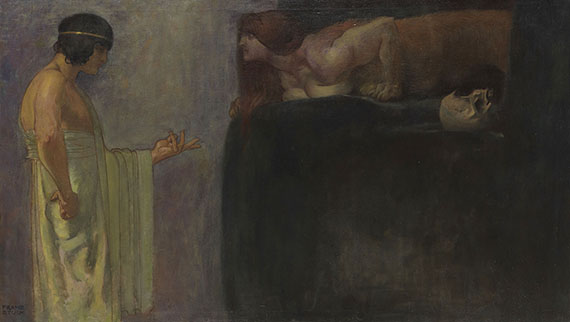Dictionary


Symbolism
Symbolism is a movement in art that lasted from around 1885 to 1920. As the name indicates, Symbolism uses symbolic interpretations and ways of expression. Its objective was to turn against Realism, as many artists felt that Realism was lacking the necessary spiritual depth that a work of art should express. On the other hand, the movement can also be understood as a reaction to Impressionism, which gives nothing but a mere account of the object's superficial properties; Symbolism, on contrary, assigns a deeper meaning to the depicted objects. All in all it can less be regarded as an independent school of art, as what artists and writers had in common was limited to a similar awareness of life and the intention to create sense behind the motif. This common attitude was a reaction to 19th century materialism. But yet, both movements - Symbolism and Materialism - can be understood as a consequence of the loss of traditional Christian spirituality and its values, which is why Symbolism tried to come up with a modern concept of the spiritual.
The term "symbolism" was used by Jean Moréas in France in 1886 for the first time, when he applied it to a literary trend that had an emphasis on lyricism. Its main representatives were Baudelaire, Mallarmé, Verlaine und Rimbaud. In art, the precursors of Symbolism go back to the 18th century. In works of artists such as William Blake or Johann Heinrich Füssli, dreams, premonitions and obsessions play an important role; religious and ancient motifs are given a new interpretation.
Late 19th century Symbolism shows parallels to Art Nouveau. In some regards it was the precursor for Expressionism and Surrealism.
Symbolist artists were, among others, Arnold Böcklin, Pierre Bonnard, Maurice Denis, Fernand Khnopff, Max Klinger, Gustave Moreau, Edvard Munch, Giovanni Segantini, Franz von Stuck, Michail Alexandrowitsch Wrubel and Edouard Vuillard.
Symbolism is a movement in art that lasted from around 1885 to 1920. As the name indicates, Symbolism uses symbolic interpretations and ways of expression. Its objective was to turn against Realism, as many artists felt that Realism was lacking the necessary spiritual depth that a work of art should express. On the other hand, the movement can also be understood as a reaction to Impressionism, which gives nothing but a mere account of the object's superficial properties; Symbolism, on contrary, assigns a deeper meaning to the depicted objects. All in all it can less be regarded as an independent school of art, as what artists and writers had in common was limited to a similar awareness of life and the intention to create sense behind the motif. This common attitude was a reaction to 19th century materialism. But yet, both movements - Symbolism and Materialism - can be understood as a consequence of the loss of traditional Christian spirituality and its values, which is why Symbolism tried to come up with a modern concept of the spiritual.
The term "symbolism" was used by Jean Moréas in France in 1886 for the first time, when he applied it to a literary trend that had an emphasis on lyricism. Its main representatives were Baudelaire, Mallarmé, Verlaine und Rimbaud. In art, the precursors of Symbolism go back to the 18th century. In works of artists such as William Blake or Johann Heinrich Füssli, dreams, premonitions and obsessions play an important role; religious and ancient motifs are given a new interpretation.
Late 19th century Symbolism shows parallels to Art Nouveau. In some regards it was the precursor for Expressionism and Surrealism.
Symbolist artists were, among others, Arnold Böcklin, Pierre Bonnard, Maurice Denis, Fernand Khnopff, Max Klinger, Gustave Moreau, Edvard Munch, Giovanni Segantini, Franz von Stuck, Michail Alexandrowitsch Wrubel and Edouard Vuillard.
Offers
Headquarters
Joseph-Wild-Str. 18
81829 Munich
Phone: +49 89 55 244-0
Fax: +49 89 55 244-177
info@kettererkunst.de
Louisa von Saucken / Undine Schleifer
Holstenwall 5
20355 Hamburg
Phone: +49 40 37 49 61-0
Fax: +49 40 37 49 61-66
infohamburg@kettererkunst.de
Dr. Simone Wiechers / Nane Schlage
Fasanenstr. 70
10719 Berlin
Phone: +49 30 88 67 53-63
Fax: +49 30 88 67 56-43
infoberlin@kettererkunst.de
Cordula Lichtenberg
Gertrudenstraße 24-28
50667 Cologne
Phone: +49 221 510 908-15
infokoeln@kettererkunst.de
Hessen
Rhineland-Palatinate
Miriam Heß
Phone: +49 62 21 58 80-038
Fax: +49 62 21 58 80-595
infoheidelberg@kettererkunst.de
We will inform you in time.




